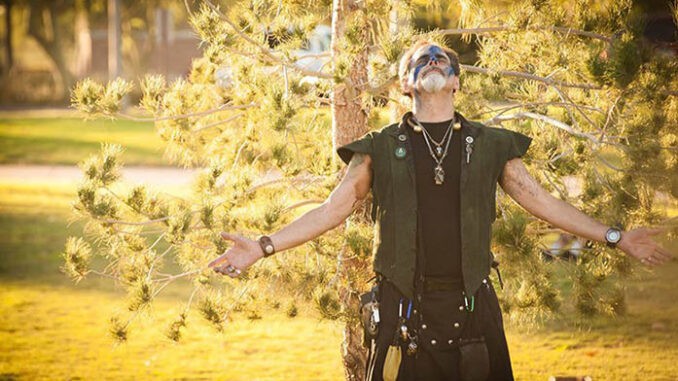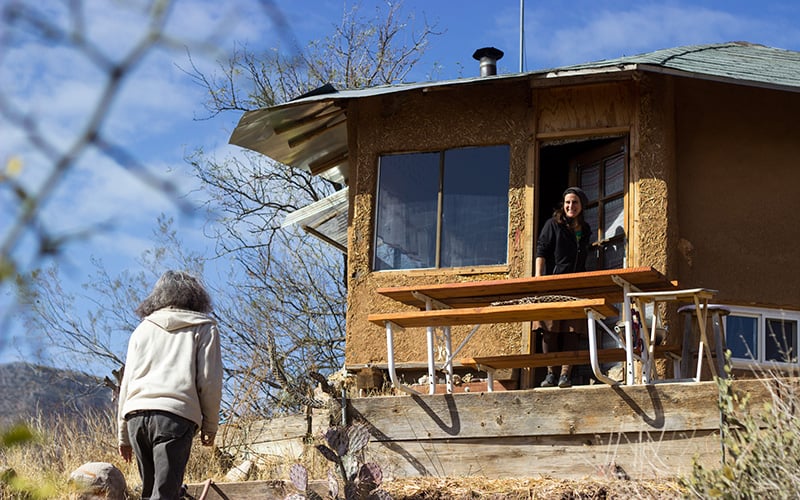
PHOENIX – Mark Bailey comes from Scottish and Mexican heritage, and he prefers Irish pubs. On a late morning, he sits in a booth at Rosie McCaffrey’s pub in central Phoenix, chatting with the waitresses as they navigate the narrow space, balancing trays of Guinness and burgers.
Bailey’s arms are covered in tattoos carrying symbolic meaning, including a falcon and a jaguar. Bailey calls the big cat his primary deity and says the falcon reminds him to focus. Another tattoo is of Red Sonja, the heroine of the sword-and-sorcery Marvel comic book. To Bailey, the red-haired warrior epitomizes the Morrigan, a Celtic goddess linked to the cycle of birth and death. Red Sonja speaks to Bailey, an aviation worker, Army veteran, historian – and druid.
Bailey is a 21st century druid. He doesn’t sacrifice animals or worship nature, and he has nuanced beliefs about an afterlife.
Druids are steeped in over two millennia of history, originating with the elites and the educated among the Celts, an Indo-European people. Modern druid practices are tamer, reincarnation is debated and human and animal sacrifices are forbidden. But modern practitioners still have much in common with their ancestors, including such traditions as ceremonies, rituals and an emphasis on education.
Beliefs and membership
Druidry is not as structured as Christianity, Islam, Judiaism and other religions. It does not hold to strict dogma, there is no universal sacred text, like the Bible or the Quran, and believers do not meet for weekly services. Most of what is known about ancient druids came from secondhand sources, including the Romans, who conquered the Celts in Britain in the first century A.D.
[metaslider id=65385]
It also is a niche group compared with other organized religious or spiritual groups. Information on the exact number of druids in the U.S. isn’t readily available, but a 2001 study by the American Religious Identification Survey shows that out of more than 200 million people interviewed, 33,000 identified as druids. The majority of participants in this survey – more than 76 percent – identified as Christian.
Bailey, 59, considered himself an atheist until he was 19, when he found inspiration in an ancient text, which he recalls this way: “Druids speak to each other as if there is a special language only they know. They start and finish each others’ sentences, but nobody else can figure out what it is they’re saying sometimes.”
Bailey has been a member of the Grove of the Rising Phoenix, an Arizona group of druids, since 2010. The Grove’s belief system is based on community, and the group celebrates ancient “hearth cultures,” including Ireland, Germany and Iceland. Although Bailey’s hearth culture is Iberia in the second century B.C., for many druids, he said, it’s Ireland in 100 B.C. to 250 A.D., a time of great druid influence.
The Grove’s 19 members include two who are inactive and live in England and three trial members, who will remain with the Grove for a year. At that point, both sides will decide whether they are a good fit for each other.
“We like to see whether their bag of crazy mixes with our bag of crazy,” Michelle West, the group’s elected senior druid, said with a laugh.
But a good fit with druid philosophy is more important than the number of members.
Bailey said he doesn’t consider druidry an organized religion, as some other druids do. The Grove of the Rising Phoenix began as a part of a larger group, ADF, “Ár nDraíocht Féin,” which means “our own magic” or “our own druidry” in modern Irish. Grove members unanimously agreed to end their affiliation in 2015 because of differences on membership strategies. ADF emphasizes recruiting; the Grove does not.
“We have our beliefs; we’re gathered because we have the same belief,” Bailey said. “There is no intent that we should grow bigger, so you’ll never see me on the street corner calling, ‘Come on out today!’ It’s more like ‘I’m going to be over here, and if you don’t like me, I’d rather be among friends. I’d rather be among people that are there for even a portion of the reason I’m there.’”
Most Grove members are in their 40s; the oldest is in her 60s. They socialize when they can and gather to honor important ancient holidays like the solstices: Beltane, on May 1, celebrating the light half of the year; and Samhain on Halloween and November 1st, honoring the dark half. They also observe St. Patrick’s Day in March because of the Roman Catholic saint’s connection to the Irish Celts and, by extension, to the druids.
Welcoming the spring solstice
The Grove’s events used to be open to the public until members decided they wanted some events solely for themselves. Now they try to rotate between public and private events. Public events typically are held at the Irish Cultural Center, and private events are held at members’ homes.
On a cool evening in March, members of the Grove gather at a home for the spring solstice. After a potluck of tacos, the sweet fragrance of jasmine permeates the air as small dogs and children tear around the backyard; in the background, music and cheering from a nearby wedding can be heard. A bonfire is lit for the ceremony, which starts after sunset.
Each druid celebration has a different leader, and the presiding druid gets to choose the myth and which hearth culture tradition they will follow, whether Irish, Greek, Norse, Celtiberian or something else. Typically, the presiding druid chooses a myth that’s seasonally appropriate for the chosen culture.
For spring, West chooses a Pennsylvania Deutsch and continental Germanic myth of creation. She reads from a version recounted on a blog post by writer Robert Schreiwer that tells of three sister goddesses, the Oschdre, who created color and then blessed a hare so it could spread color throughout the world. Although she does not speak German, West tells the story in English and German; her wife, who was born in Germany, helps with the pronunciation.
West stands at an altar adorned with a deep pink candle, flowers, a decorative hammer, liquor bottles and a small wooden statue of the Celtic goddess Brigid, patroness of the Grove. She is a triple deity – poet, healer and smith.
“Nature spirits … ancestors … shining ones … welcome,” West says, opening the ceremony. “We shall meet here at the sacred center when we open the gates to the other worlds.”
After a half hour of spoken word and singing, the members make their sacrifices, pouring alcoholic beverages into the bonfire, which stokes the flames and throws sparks into the darkness. Then they poured in bourbon nine times, one for each realm in Norse mythology. A woman drops a long-stemmed flower into the flames. Someone else throws in a paper plate of food, which burns for several minutes before being consumed.
The special number
The three sister goddesses of the Oschdre resonate with Grove members because the number has special meaning among druids. The ancient Celts believed there were three realms: land, sea, and sky. Echoing that is an expression popular with Grove members: “Ask a druid a question and you’ll get three different answers. Ask three druids a question and you’ll get nine different answers.”
Modern druids seem to fall into three types, or three areas that druids choose to focus on: history, nature and magical practices.
Bailey and West identify with the first type.
West refers to the Grove, which is affiliated with the Irish Cultural Center in downtown Phoenix, as “part religious organization, part historical society.” Bailey, West and others members teach a series of lectures at the center on subjects ranging from ancient languages to ancient Celtic festivals. They also perform a deity-generic ritual at the center’s annual winter solstice event, based on the seasonal values of hope, light and community.
Bailey’s most recent lecture was on the Battle of Clontarf, an 11th century battle between the Irish and Vikings who had settled in Ireland. He prepared a PowerPoint presentation and brought in some props – 19 pounds of metal armor based on what many Vikings wore; knives and a spear; neck ornaments called torcs worn by Celts to show their accomplishments, and a reindeer pelt (although Bailey says the Irish would more likely have worn wolf pelts).
Bailey is an aviation logistics expeditor, building aircraft parts, but history has been a longtime passion of his. He began studying medieval history for his master’s degree but switched to business after serving in Afghanistan, he said. He got his bachelor’s and master’s degrees while working a 12-hour job seven days a week, doing his coursework in the early morning before work and late at night.
He believes that all deities are sitting at a giant table – among them Jesus and Amaterasu, the Japanese goddess of the sun. From there, they are watching us and rolling their dice to decide what we’ll do next.
“Every time we do something screwed up down here,” he said, “I think all of the gods pull out their dice, pull out their shekels.”
History vs. modern times
In ancient times, druids were among the best educated members of Celtic society, serving as judges, teachers and scholars, according to druidry.org.
There are differences between the ancient practices and the modern ones. Modern druids are much tamer than their predecessors, as animal and human sacrifices are no longer acceptable in druidry. Instead, members of the Grove sometimes use a piñata full of red candy. Alcohol is a popular sacrifice for gods, spirits and ancestors at the Grove’s solstice event, and so is food, often given to a fire as an offering.
West compares the process to a give-and-take relationship, like a friendship.
“If you have a friend who only calls you to ask for favors, eventually you just stop picking up,” she said. “You build a reciprocal relationship with your ancestors, with your communities, with whatever it is that you feel is going to be able to provide what you need – whether it’s through prayer, offerings, spoken word or song, whether it’s through actual physical offerings of incense or alcohol or the first bite of food from your plate.”
Still, Grove members believe that if ancient druids were somehow transplanted to a Grove ritual, they would understand and be able to take part.
Modern druid beliefs about the afterlife vary, and West says that reincarnation is a debated topic in the community. Records showed that ancient druids taught reincarnation, but it the details of what they believed are unknown. Most modern druids believe in life after death, but opinions differ on what exactly that life can be. Some believe that humans can come back as animals or insects in their next lives, and others do not.
Bailey believes in transmigration of the soul, distinct from reincarnation because in transmigration the person has less of a connection to their past lives. The soul moves from one body to another after death and past life memories cannot be accessed.
He believes he will be reborn near where his skull is buried. He imagines this new person will enjoy life, talk and memorize a lot.
“Seventy years from now, they’ll be sitting down, I hope in an Irish pub, telling stories for somebody else as well,” Bailey said of his future being. “But me, I’ll be gone. That’s OK. Maybe my stories will live on.”

